Table of Contents
Stoves
Camping stoves come in two basic types: gaseous (propane/butane/isobutane) or liquid fuel. They are usually single burner units although dual and even triple “suitcase” stoves are available.
Propane stoves currently dominate the market due to simplicity, inexpensive design, minimal smell and widespread retail availability of propane bottles. Propane stoves are generally regarded safe to burn indoors with ventilation, fume-wise at least.
Butane stoves can be similar in design to propane stoves, other than running on a different kind of fuel. Butane is less popular due to higher fuel costs, somewhat lower availability of fuel canisters, and poor performance in freezing conditions.
Isobutane stoves typically consist of very lightweight burners that screw directly onto squat fuel canisters. They are very popular with backpackers due to reduced weight but fuel cost is much higher than butane or propane. Cold weather performance is improved over butane due to the addition of ~20% propane in the fuel mix.
See this comparison of the gaseous fuels.
Liquid-fuel pressure stoves run on compressed liquid fuel of some kind, traditionally Coleman fuel or unleaded. They were the default stoves for decades before the rise of propane. Pressure stoves typically cost less to run1), put out more BTU in a smaller package. The tradeoff is smellier fuel than propane and more complexity than the “turn the knob and light a match” starting procedure seen in propane gear. Liquid fuel stoves are generally not used indoors – they flare during startup, and emit fumes strongly when starting or extinguishing.
See this comparison that includes liquid fuels.
Electric stovetops, either traditional resistive or induction, have become popular because of the “clean and shiny” look and how pretty they are on Instagram. However cooking with electricity is realistically only possible with shore power, or for those who have spent tens of thousands of dollars on their house electrical system.
There are other, sometimes more exotic fuels often used used by backpackers who watch their grams.
countertop stoves
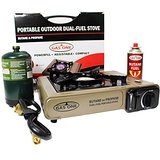 Countertop stoves have short feet or a flat bottom and fare best on a table, counter, or other wide/flat surface. They are stable in use and are much akin to using a hot plate.
Countertop stoves have short feet or a flat bottom and fare best on a table, counter, or other wide/flat surface. They are stable in use and are much akin to using a hot plate.
Bob recommends the ONE dual propane/butane stove pictured left.2)
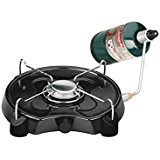
Another popular countertop stove is the Coleman propane stove pictured right.
Since countertop stoves are relatively wide some 'dwellers opt for slimmer camping models.
camping stoves
gaseous fuel
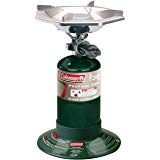 “Bottletop” propane camping stove burners mount directly to the top of the 1# bottle. This makes for light weight and easy storage, but can also be top-heavy and unsteady. Even so, these stand-up stoves by Coleman and others are quite popular. The Martin stove out of Canada is reputed to have the highest quality valve and burner.
“Bottletop” propane camping stove burners mount directly to the top of the 1# bottle. This makes for light weight and easy storage, but can also be top-heavy and unsteady. Even so, these stand-up stoves by Coleman and others are quite popular. The Martin stove out of Canada is reputed to have the highest quality valve and burner.
There are also ultralight stoves for isobutane3) containers, but the fuel is expensive so they are most often used only by hikers and backpackers for whom light weight is more important than fuel cost. Lindal valve adapters can be used to run isobutane burners on propane or butane.
Related: guide to gaseous fuel connectors
For people who need to conserve space and who mainly use stoves to boil water, a JetBoil system makes efficient use of isobutane.
pressurized liquid fuel
Liquid fuel pressure stoves do not burn liquid fuel directly; they gasify (atomize) the liquid fuel into a vapor that the stove can burn efficiently. Gasification occurs in a gas generator, which is a portion of the fuel delivery tube that pass near or through the burner's flames. The liquid fuel hisses as it vaporizes in the generator.
Until the generator is hot enough to gasify the fuel, the stove will flare up, generally misbehave, and smell strongly of fuel. This can be alarming to first-timers, and may be responsible for the overall decline in pressure stoves in the camping stove market. Flare up can be minimized by pre-heating with alcohol: a bit is poured on the burner area near the generator and lit on fire. Just before the alcohol fire is goes out the liquid fuel valve is gently opened. This technique is especially helpful in very cold ambient temperatures where the flare-up could last a while.
Lighting demo (youtube)
skeleton
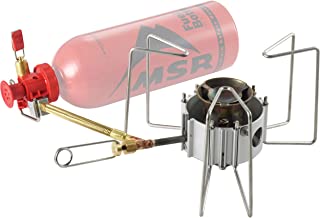 Skeleton stoves can be more squat and steady as they don't have to work around the inherent height of the propane or liquid fuel bottle.
Skeleton stoves can be more squat and steady as they don't have to work around the inherent height of the propane or liquid fuel bottle.
Pro: The Dragonfly pictured above is known for simmer regulation. Field maintainable and repairable. Some people like the sound.
Con: Cost about 2x as much as a non-skeleton regular pressure stove. This type of “roarer” stove can be quite loud.
sportster
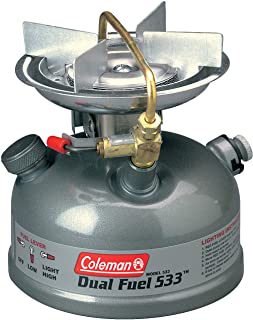 The most popular current sportster (single burner fount-top) stove is the Coleman 533 Dual Fuel. The stove can run on Coleman fuel (white gas) or unleaded. Note that unleaded will foul the generator (fuel gasification tube) more quickly.
The most popular current sportster (single burner fount-top) stove is the Coleman 533 Dual Fuel. The stove can run on Coleman fuel (white gas) or unleaded. Note that unleaded will foul the generator (fuel gasification tube) more quickly.
Note that some compact sporster stoves can overheat their fuel tank if too wide a pan is used:
It affects any stove that has the burner and fuel tank close to each other, which is common in small, portable, or backpacking singleburner stoves. The reason wide pans are deprecated is that they reflect more heat back onto the tank/font. Taller, narrower pots will help the stove run cooler if it is prone to overheating.4)
suitcase
Suitcase stoves have two or more burners and are shaped like a suitcase.5). Because of their large size they are uncommon in the vandwelling world.
alcohol
Alcohol stoves are found in open, low-pressure, and high-pressure configurations – the latter is rare except for marine applications.
Low pressure stoves may be:
- freestanding (no pot needed to seal the top); or
- pot-sealed, where the cooking pot must be in place for jet formation.
In all cases it takes a minute or so for pressure (and therefore jets) to form
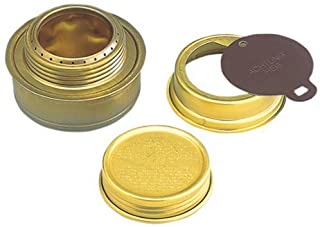 The most common commercial alcohol stove is the Trangia type: a freestanding, low pressure, double-walled stove that holds about an ounce of fuel.
The most common commercial alcohol stove is the Trangia type: a freestanding, low pressure, double-walled stove that holds about an ounce of fuel.
The simplest hiking stove is a "penny" alcohol stove, so called because in some variants a penny is used to cover the fill holes.
solid fuel
sterno
Sterno is a jellied alcohol fuel. It is rarely used in vandwelling because of the cost and because the flames are nearly invisible.
hexamine
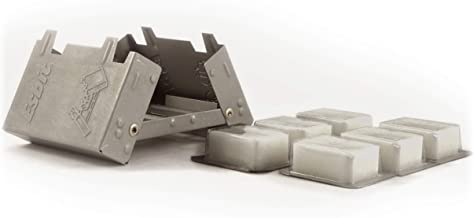 Hexamine bars or tablets (esbit, military surplus) are very expensive by the BTU produced (and relatively sooty-burning) but are lightweight and stable. They make great additions to day packs and emergency bags.
Hexamine bars or tablets (esbit, military surplus) are very expensive by the BTU produced (and relatively sooty-burning) but are lightweight and stable. They make great additions to day packs and emergency bags.
tin can stove
The simplest stove is a cut-out tin can, often called a “twig” or “hobo” stove.
Pro:
- free, craftable from found objects
- free fuel when available and legal (ie, no burn bans)
- refuelable during operation
Con:
- bulky
- sooty
rocket stoves
 Rocket (gasifying) stoves are more efficient than traditional stoves. Small portable versions exist for the camping market.
Rocket (gasifying) stoves are more efficient than traditional stoves. Small portable versions exist for the camping market.
…rocket stoves used 18 to 35 percent less fuel compared to the traditional stoves and reduced fuel used 39-47 percent compared to the simple traditional open three-stone fire, as well as a large reduction in emissions.6)
In real world terms this means less smoke and more heat for a given amount of fuel. The camping versions also run quite well on small “scrap” fallen wood like bark freagments, twigs, chunks of partially burned wood, etc.
electric stoves
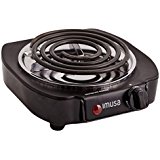 Electric stovetops are generally used by folks who use campsites with electric hookups, although generator or big solar setups with lithium banks are sometimes used.
Electric stovetops are generally used by folks who use campsites with electric hookups, although generator or big solar setups with lithium banks are sometimes used.
resistance vs induction comparision
| resistance | induction | |
|---|---|---|
| price | less expensive | more expensive |
| inverter requirement | MSW or PSW | PSW only |
| efficiency | 75-80% | 85% |
| temperature control | on/off thermostat. Heat output can be adjusted with a triac. | on/off thermostat. Some models have variable power (see below) |
| cookware | any | induction-compatible only. If it strongly attracts a magnet it will work with induction. |
Resistance and induction cooking both use 1000-2000w watts of power to run each “burner” although the induction unit will be 5-10% more efficient.7)
metrics for induction cookers with variable power
Although power is generally ON/OFF at full blast with temperature controlled by varying the duty cycle, some induction units seem to use regulated amounts of power. Of special note is the Nuwave Pic that allows manual choice of 600w, 900w, or the default 1,300w.
Max Burton 6400 Digital Choice Induction Cooktop 1800 Watts8)
- 0w - 750w (cycles on/off)
- 782w
- 962w
- 1140w
- 1232w
- 1312w
- 1402w
- 1484w
- 1544w
- 1623w
True Induction double burner 9)
- switches 0 - 627W
- switches 0 - 734W
- steady draw of 734W
- 820W
- 890W
- 978W
- 1067W
- 1260W
- 1436W
- 1540W
NuWave Precision Induction cooktop:10)
- Low = 100deg drew about 650 watts.
- Med. low = 175deg drew about 650 watts
- Medium = 275deg drew about 1030 watts
- Med. High. = 375deg drew about 1300 watts
- High = 425deg drew about 1580 watts
- Max/Sear = 650deg drew about 1680 watts.
lower-wattage induction cooktops for portable use
Most of these are sized for pots with flat 4“-6” bottoms.
- 700w-200w “in six steps”11) - GastroGear. 6 temperature settings (176°F-266°F)
- 500w/300w/250w - JOZOOES. No temperature control.
- 500w/400w/300w/200w/100w - Abangdun (square). No temperature control.
- 500w/400w/300w/200w/100w Abangdun (round). As above in different form factor and touch/slide controls.
fuel cost
from most cheapest/BTU to most expensive:
- unleaded - available everywhere
- generic coleman fuel as found in walmart, etc - found in some places
- actual Coleman fuel - usually available
- propane in the 15# canisters - widely available, look for the propane cages outside
- propane in the 1# canisters - widely available
- butane - found in some places
- isobutane - found in some places
conserving fuel
The amount of fuel consumed can be reduced if needed:
- check food at the minimum cook time to see if it's already done, or is done enough it can be removed from heat
- reduce heat as much as possible when maintaining simmers
- reduce ingredient thickness (smaller slices, thinner pastas like angel hair)
- use windbreaks to keep heat focused on the pot
- use a pot wide enough to take the whole flame; flames that go up the side of the pot are not performing useful work. Note: excessively wide pans can overheat the fuel tank of sportster-style stoves (above).
- cover pots to retain heat (and reduce the amount of moisture released)
- use cold “cooking” techniques like cold brew coffee and refrigerator oatmeal
- use cook-and-coast cooking methods like thermos cooking or “coasting” to cook hard boiled eggs
- use electric cooking if shore power is available or if you have excess power you have made off-grid
- boil only the amount of water you will need in the near future
- preheat water and cookware by leaving receptacles in the sun
- use a pressure cooker for cooking beans, rice, etc.
- use a solar oven
- if cooking with organic fuels like firewood, use a "rocket"-type gasifier or other efficient stove
- maintain fuel stoves if it does not burn with a clear blue flame

